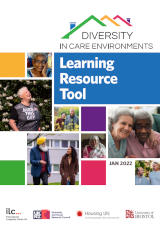Episode One: Ann
Ann is a woman in her late 60s, who has lived at an extra care housing scheme for the last nine years. Her career as a nurse saw her working in the field of mental health and with people with learning disabilities. She grew up as a black woman in a largely white neighbourhood. During her childhood, Ann experienced racism from other children which included physical attacks. However, whilst in the minority as a black woman, she does not perceive that she has experienced racism where she is currently living.
In the accompanying podcast, Ann describes how, whilst she enjoys living at her housing scheme, the attitudes of a minority of residents makes living there difficult. She speaks of feeling encouraged by how the staff at her scheme have responded to resolve the situation.
- ♫ Listen to the podcast ♫
- Download the transcript (opens new window)
Questions to consider:
- How does your organisation seek to challenge discrimination and to support the social inclusion of residents?
- What processes exist in your organisation for residents to report discrimination?
- How can scheme staff get to know new residents and what matters to them?
- How can staff and managers encourage a more respectful environment amongst residents?
- How can staff and managers ensure that residents feel that their concerns matter and that they will be acted upon?
- What are the roles of staff and managers in recognising social difference and making residents feel safe and valued?
- What does a whole-community approach to social inclusion look like within housing schemes?
Key learning points:
- It is important for scheme staff and managers to develop relationships of trust with residents. Such relationships will ensure that residents feel that they can approach staff and managers and that managers and staff will also feel able to enter discussions with residents where there may be difficult relationships and potential conflict. This includes ensuring that residents are aware of the processes for reporting discrimination.
- Housing providers need to provide staff and managers with equality and diversity training, which includes training in inclusive language. Training for staff in how to respond to and mediate difficult resident relationships should also be mandatory. Staff need to ensure that they model attitudes of respect and inclusion in their own practice and conduct.
- The visibility of posters and affirming images (such as pictures of people in same-sex couples or of ethnically diverse people and groups) within communal areas of schemes can send a message that housing communities support inclusion and value resident difference.
Key legislation to consider:
Equality Act 2010 (opens new window) – race and disability are protected characteristics under the Act.
Episode Two: Jane
Jane is a white woman who identifies as transgender. Jane has lived at her housing scheme on the outskirts of London for the past 11 years. The housing scheme has shared outside space which residents use during warmer weather. Besides a laundry room, there are no other indoor communal areas. During Jane’s time living at the scheme, transphobic literature was found in the communal laundry room. Jane feels that this was a ‘one-off’ incident, which the scheme manager handled to her satisfaction.
In the accompanying podcast, Jane speaks of why she was attracted to live at the housing scheme and how, while she values her privacy, opportunities for her to socially connect with other residents are limited.
- ♫ Listen to the podcast ♫
- Download the transcript (opens new window)
Questions to consider:
- What role do staff and housing providers play in making residents feel valued and included where they are living?
- What role do pets have in supporting residents to feel ‘at home’ where they are living?
- How do you support residents to live the life they want to live?
- How welcoming is your organisation to residents identifying as transgender?
- How can residents be supported with experiences of grief and loss?
- How can residents be encouraged to maintain a balance between privacy and interacting with other residents which is right for them?
- Indoor and outdoor communal areas are much-needed spaces where residents can connect with other residents on an everyday basis. If these areas do not exist in your housing scheme, are there community rooms and spaces that residents could access in the local area?
Key learning points:
- Animal companions are vital to some residents’ wellbeing. Housing schemes that allow and encourage pet ownership can positively impact resident wellbeing. Pet ownership may also counteract feelings of loneliness and help to reduce isolation.
- Staff and managers can support individual residents to find the right balance of privacy and solitude without becoming isolated. This is particularly important for those who have experienced loss through a change in relationship or bereavement (including the loss of animal companions).
- Housing providers need to provide mandatory equality and diversity training for staff, which includes discussions about the importance of respecting residents who belong to minority groups and using inclusive language, such as the correct use of gender pronouns.
Key legislation to consider:
Data Protection Act 2018 (opens new window) - protecting people’s personal information, including details about their gender identity.
Gender Recognition Act 2004 (opens new window) – an Act of law that provides transgender people with legal recognition of their gender identity.
Equality Act 2010 (opens new window) – race, disability and gender reassignment (inclusive of all trans people) are protected characteristics under the Act.
Episode Three: Robert
Robert is a 78-year-old man who lives in an extra care housing scheme for older people. Robert identifies as gay and moved into the scheme with his long-term partner 10 years ago, as Robert required some extra support with caring for his partner’s needs. They moved into the scheme when it was first built and Robert praises the design of the scheme with its wide corridors, large bathrooms, open plan living and dining room, and communal spaces, including an on-site restaurant and a large garden surrounded by woodland.
In the accompanying podcast, Robert describes the transition of moving into the scheme, being welcomed by the manager and interactions with other residents.
- ♫ Listen to the podcast ♫
- Download the transcript (opens new window)
Questions to consider:
- How important is the design of housing schemes for the inclusion of residents? How can communal spaces be used in an inclusive way?
- What role do scheme staff have in encouraging greater inclusion? How do you think they can do this?
- How can scheme staff recognise and support new residents who may identify as LGBT+ (lesbian, gay, bisexual and transgender)?
- Unlike Robert, not all residents can speak up for themselves or feel confident to challenge discriminatory views from others. What role do staff and housing providers have in challenging discriminatory remarks and actions within schemes?
- How can staff support residents to speak up for themselves amongst other residents?
- What training and support should staff receive to help them to support residents?
- How can staff support residents to engage in the activities that matter to them?
Key learning points:
- The built environment is important for supporting the continuation of care for a partner (for example, appropriate adaptations).
- Housing providers and scheme managers need to work with residents from minority backgrounds to ensure inclusion. On-site staff who have built rapport and trust with residents are vital to ensuring that residents from minority backgrounds are not discriminated against and that they feel valued and included.
- Robert suggests that scheme managers could play a role in encouraging the inclusion of new residents through introductions at coffee mornings in communal areas. He discusses his hope to have his wedding party in the communal area of the scheme, highlighting the value of communal spaces, and the importance of managers and other residents being receptive to the hosting of life-events that are significant to residents.
- Scheme staff and managers need to make sure that the Equality Act 2010 is fully implemented and ensure that they provide safe, inclusive living environments for all residents. They need the full support of their employer to do this well.
Key legislation to consider:
Sexual Offences Act 1967 (‘1967 Act’) – this Act led to the decriminalisation of sex between men. Prior to this Act sex between men was a criminal act in England and Wales.
Equality Act 2010 (opens new window) – race and sexual orientation are protected characteristics under the Act.
Episode Four: Sasha
Sasha is a lesbian in her late 60s. She has lived alone in a one-bedroom flat, located in a rural retirement village, for the past six years. The scheme benefits from a large communal grassed area, however it has no internal communal spaces. Sasha originates from Germany but has been living in the UK since the 1980s, when she was an active member of the LGBT+ community. She currently experiences poor physical and mental health which sees her confined to her flat on most days. She views herself as very much a minority amongst other residents at the scheme where she lives and reports that she stopped attending summer outdoor activities due to some xenophobic and racist attitudes expressed by other residents.
On the accompanying podcast Sasha describes her past, the fact that she previously worked as a housing scheme manager, and how this has informed her expectation of the role of a scheme manager.
- ♫ Listen to the podcast ♫
- Download the transcript
Questions to consider:
- How can staff support residents to maintain their individuality and sense of self when their life is restricted by poor health or disability?
- What role does digital technology play in supporting residents to maintain their independence?
- How does your organisation celebrate the different cultural, spiritual and social beliefs of residents?
- What processes exist in your organisation for residents to report discrimination?
- What links does your organisation have to community groups and services that represent the rights of people belonging to different characteristics? For example, groups and services for LGBT+ people or for different ethnic communities.
- How can residents experiencing poor health or restricted mobility be supported to be included in resident communities?
- Who at your organisation can residents speak to about equality and discrimination concerns? How are residents informed of this?
Key learning points:
- On-site staff and estate managers are key to ensuring that residents do not become isolated, especially residents who are not able to leave their homes due to physical and/or mental ill health.
- Good digital connectivity and access to Wi-Fi is important to ensure that residents can connect with online groups and communities. This is particularly relevant for residents who have minority identities and value connections with other individuals and groups with shared or similar identities, and for residents confined to their homes due to poor physical or mental health or long-term impairments.
- Residents should be made aware of local community groups and organisations that support residents identifying with minority groups. Broad awareness could be raised via the display of information in communal areas or via resident newsletters.
- Providers need to issue policies on responding to and challenging discrimination from scheme staff or residents and such policies need to be publicly available for all staff and residents to read. Managers must also ensure that there are confidential channels available for residents to report discrimination and that they are regularly reminded of these.
Key legislation to consider:
Equality Act 2010 (opens new window) – race, sexuality and disability (including mental health) are protected characteristics under the Act.
Episode Five: Ward
Ward is a 73-year-old man who lives in an inner-city retirement housing scheme. Ward identifies as gay and, over the course of his adult life, has been heavily involved with LGBT+ campaigning and social groups. He has lived in his current scheme for eight years, having previously lived in a similar scheme owned by the same housing provider.
In the accompanying podcast, Ward describes his long-term interest in issues of equality and diversity, the built environment of the scheme where he lives and his involvement with his housing provider’s training of staff.
- ♫ Listen to the podcast ♫
- Download the transcript (opens new window)
Questions to consider:
- In his discussions of equality and diversity, Ward discusses social justice. What is meant by social justice and why does it matter in housing communities?
- Ward discusses social connections inside and outside of the scheme where he lives. Why are social connections within schemes and outside of schemes important to residents? What role do staff have in supporting residents to develop and maintain these connections?
- How would you address the isolation of residents within the scheme where you work, for example when residents might be ‘stuck in their flats’?
- Ward mentions the need for more adaptations for disabled residents and people with dementia within housing schemes. How can housing communities be made more inclusive for disabled residents and people with dementia?
- How can residents be encouraged to be actively contribute to and be involved in staff training on inclusion, equality and challenging discrimination?
- How can schemes actively encourage older people from diverse backgrounds to join their community? What groups and services within the locality may be vital here?
Key learning points:
- It is important for staff and residents to understand the concept of inclusion, being aware of its focus on protected characteristics as well as people’s individual values. In relation to this, staff need to be aware of what individual biases and prejudiced beliefs they might hold about people based on characteristics such as race, ethnicity, sexuality and gender (sometimes referred to as unconscious biases). These biases and beliefs might make it difficult for staff to respond appropriately to resident complaints of discriminatory or unfair treatment. Staff awareness training around equality and diversity should include this.
- Scheme managers and staff have a vital role in learning about and improving awareness of different sexual identities and relationships. Ward highlights the good practice of residents and local LGBT+ groups being consulted about staff training - this could, and should, be integrated across whole organisations rather than just occurring in individual schemes. Managers need to be consistent in their approaches to promoting and instigating inclusive practices across housing providers.
- Scheme managers and staff need to support residents to maintain connections both inside and outside of schemes. A sense of community within schemes and in their surrounding areas can facilitate a sense of inclusion amongst residents.
Key legislation to consider:
Sexual Offences Act 1967 (‘1967 Act’) – this Act led to the decriminalisation of sex between men. Prior to this Act sex between men was a criminal act in England and Wales.
Equality Act 2010 (opens new window) – race and sexual orientation are protected characteristics under the Act.
Episode Six: About the DICE study
This is part six about what lies behind the research project and we meet the researchers themselves.
- ♫ Listen to the podcast ♫
- Download the transcript (opens new window)
Acknowledgements
The resources on these webpages are based on findings from the Diversity in Care Environments (DICE) research study, conducted by the University of Bristol, in collaboration with the International Longevity Centre-UK (ILC) and The Housing Learning and Improvement Network.
The study and related resources were funded through a research grant from the UK Economic and Social Research Council (UKRI, grant reference ES/R008604/1), January 2019 to January 2022.





